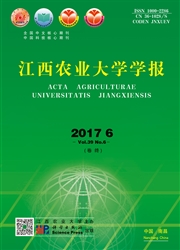

 中文摘要:
中文摘要:
以大岗山林区第6次森林资源二类清查资料和林区内沿海拔352~775m杉木人工林样带调查数据为依据,利用已发表的生物量与蓄积量模型和材积源生物量法(乔木层)、样方收获法(灌木、草本和枯落物层)和森林类型法(土壤层)研究大岗山林区杉木人工林碳密度特征及分配规律。研究结果表明,杉木有机碳含量随年龄和器官的变化均不显著;杉木林乔木层碳密度随年龄的增加而增大,随着密度的增加而减小;坡向和林分郁闭度对杉木乔木层碳密度的影响显著,坡位的影响不显著;杉木林土壤的有机碳含量随着土层深度的增加而减小,40cm以上土层内变化较大,40cm以下变化较小,受枯落物分解特征的影响,不同年龄林地的土壤有机碳含量和碳密度变化较复杂;不同年龄杉木林枯落物碳密度大小次序为:中龄林、成熟林、幼龄林、过熟林和近熟林,储存碳素具有一定的周期性。杉木人工林生态系统中地上部分(植被碳库)与地下部分(土壤和枯落物碳库)之比为1:3.72,地下部分是一个重要的碳库。
 英文摘要:
英文摘要:
Based on the sixth forest resources second - class inventory materials and belt transect from 352 to 837 meters above sea level in Dagangshan Mountains, with the help of references on models of biomass and volume, by Volume- Biomass methods for trees, harvesting methods for shrubs, herbs and litters, and forest classification methods for soils, the characters of carbon density and its distribution in Chinese fir plantations were investigated. Through comprehensive research on many factors, some conclusions were drawn. Effects of age and organs on organic carbon content of Chinese fir had no significant differences. As trees grew, carbon density became larger. However, as trees were planted thicker,carbon density became smaller. Aspect and crown density had great effects on carbon density. Carbon density of different slope positions had no obvious difference. As soil became deeper, carbon content and carbon density became smaller, and they varied greatly in the soil layer of 40 cm depth, but changed slightly below. Because of influence of litter decomposition rate,soil organic carbon content and carbon density of different ages changed irregularly. The order of the carbon densities of the litter of forests of different ages was half - mature forest 〉 mature forest 〉 young growth forest 〉 postmature forest 〉premature forest. Carbon reservation showed some periodicity. Ratio of overground to underground carbon sink was 1 to 3.72, it indicates that the latter is a stable huge carbon sink in Chinese fir plantations ecosystem.
 同期刊论文项目
同期刊论文项目
 同项目期刊论文
同项目期刊论文
 Foliar and soil N-15 natural abundances provide field evidence on nitrogen dynamics in temperate and
Foliar and soil N-15 natural abundances provide field evidence on nitrogen dynamics in temperate and CO2 Flux Estimation by Different Regression Methods from an Alpine Meadow on the Qinghai-Tibetan Pla
CO2 Flux Estimation by Different Regression Methods from an Alpine Meadow on the Qinghai-Tibetan Pla Rice to vegetables: short versus long-term impact of land use change on the indigenous soil microbia
Rice to vegetables: short versus long-term impact of land use change on the indigenous soil microbia C-13 abundance, water-soluble and microbial biomass carbon as potential indicators of soil organic c
C-13 abundance, water-soluble and microbial biomass carbon as potential indicators of soil organic c Spatiotemporal dynamics of aboveground primary productivity along a precipitation gradient in Chines
Spatiotemporal dynamics of aboveground primary productivity along a precipitation gradient in Chines Mechanism and bio-environmental controls of ecosystem respiration in a cropland in the North China P
Mechanism and bio-environmental controls of ecosystem respiration in a cropland in the North China P Litter production, leaf litter decomposition and nutrient return in Cunninghamia lanceolata plantati
Litter production, leaf litter decomposition and nutrient return in Cunninghamia lanceolata plantati Responses to N and P fertilization in a young Eucalyptus dunnii plantation: Microbial properties, en
Responses to N and P fertilization in a young Eucalyptus dunnii plantation: Microbial properties, en Effects of vegetation control on ecosystem water use efficiency within and among four grassland ecos
Effects of vegetation control on ecosystem water use efficiency within and among four grassland ecos 期刊信息
期刊信息
